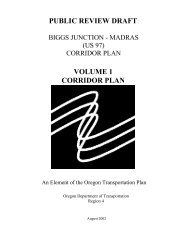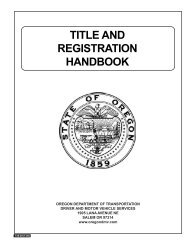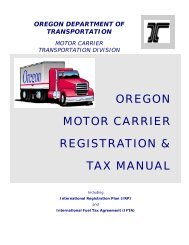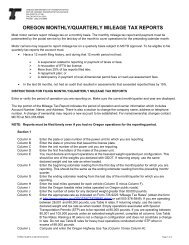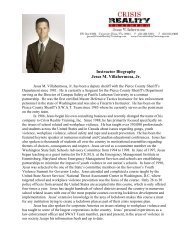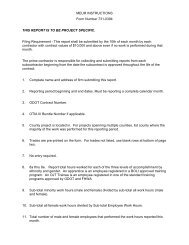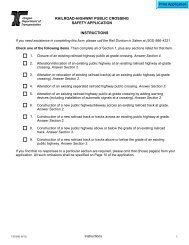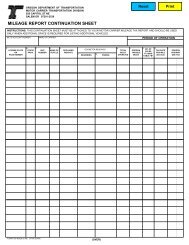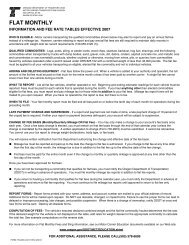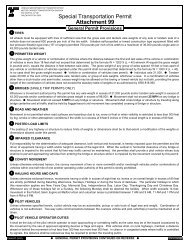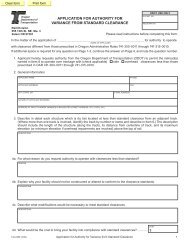Guide to Farm Trucking in Oregon - Oregon Wheat Grower's League
Guide to Farm Trucking in Oregon - Oregon Wheat Grower's League
Guide to Farm Trucking in Oregon - Oregon Wheat Grower's League
You also want an ePaper? Increase the reach of your titles
YUMPU automatically turns print PDFs into web optimized ePapers that Google loves.
2012 Edition<br />
<strong>Guide</strong> <strong>to</strong><br />
<strong>Farm</strong> <strong>Truck<strong>in</strong>g</strong><br />
<strong>in</strong> <strong>Oregon</strong><br />
Revised: Sept. 2012
This publication is a basic guide <strong>to</strong> farm<br />
truck<strong>in</strong>g <strong>in</strong> <strong>Oregon</strong>. But it cannot conta<strong>in</strong><br />
everyth<strong>in</strong>g a farmer needs <strong>to</strong> know.<br />
<strong>Farm</strong>ers with questions about regulations can<br />
contact their association representatives or the<br />
<strong>Oregon</strong> Department of Transportation at the<br />
numbers listed here.<br />
<strong>Oregon</strong> Department of Transportation<br />
Mo<strong>to</strong>r Carrier Transportation Division<br />
550 Capi<strong>to</strong>l Street NE<br />
Salem OR 97301-2530<br />
503-378-2399<br />
<strong>Farm</strong> Desk: 503-378-5203<br />
www.oregon.gov/ODOT/MCT<br />
Also, see page 37 for a list of ODOT<br />
Mo<strong>to</strong>r Carrier Division offi ces throughout <strong>Oregon</strong>.<br />
<strong>Oregon</strong> <strong>Farm</strong> Bureau<br />
3415 Commercial Street SE<br />
Salem OR 97302<br />
503-399-1701<br />
www.oregonfb.org<br />
<strong>Oregon</strong> <strong>Wheat</strong> Growers <strong>League</strong><br />
115 SE 8th<br />
Pendle<strong>to</strong>n OR 97801<br />
541-276-7330<br />
www.owgl.org<br />
<strong>Oregon</strong> Association of Nurseries<br />
29751 SW Town Center Loop West<br />
Wilsonville OR 97070<br />
800-342-6401 or 503-682-5089<br />
www.oan.org
<strong>Guide</strong> <strong>to</strong> <strong>Farm</strong> <strong>Truck<strong>in</strong>g</strong> <strong>in</strong> <strong>Oregon</strong><br />
Contents<br />
<strong>Farm</strong> <strong>Truck<strong>in</strong>g</strong> <strong>in</strong> <strong>Oregon</strong> -- The Basics ...........4<br />
Benefi ts of <strong>Oregon</strong> <strong>Farm</strong> Certifi cation ...............6<br />
Permitted Uses of <strong>Farm</strong>-Plated Trucks .............7<br />
“T” Truck Plate Requirements ...........................8<br />
Determ<strong>in</strong><strong>in</strong>g Registration Weight ......................9<br />
Over-Dimension Permits .................................10<br />
Operat<strong>in</strong>g Trucks Under Lease Agreements ...12<br />
For-Hire Haul<strong>in</strong>g ..............................................13<br />
Intrastate vs. Interstate Commerce .................14<br />
<strong>Farm</strong> Truck Operations Checklist ...................15<br />
General Applicability of Safety Regs ...............15<br />
Insurance ........................................................15<br />
Parts & Accessories ........................................16<br />
Inspection, Repair, and Ma<strong>in</strong>tenance ..............17<br />
Annual Truck Safety Check .............................17<br />
Driver Qualifi cations ........................................18<br />
CDL Requirements..........................................18<br />
<strong>Farm</strong> Endorsements .......................................19<br />
Drug and Alcohol Test<strong>in</strong>g ................................20<br />
Interstate Driver Hours-of-Service ..................21<br />
Vehicle Identifi cation .......................................22<br />
Trailer and Truck Trac<strong>to</strong>r Mark<strong>in</strong>gs .................23<br />
Rear Impact Guards ........................................24<br />
Crash Report<strong>in</strong>g ..............................................25<br />
Load Securement ............................................26<br />
Applicability of safety regulations<br />
when operat<strong>in</strong>g <strong>in</strong> <strong>in</strong>terstate commerce<br />
<strong>Farm</strong> trucks 10,000 lbs. or less ......................28<br />
<strong>Farm</strong> trucks 10,001 lbs., up <strong>to</strong> 26,000 lbs. ......30<br />
<strong>Farm</strong> trucks 26,001 lbs. or more .....................31<br />
<strong>Farm</strong> Operations <strong>in</strong> <strong>Oregon</strong>’s Neighbor States ..32<br />
Types of Truck Safety Inspections .....................34<br />
Level 2 “Walk Around” Checklist .........................35<br />
For-Hire <strong>Farm</strong>er Records Requirements ............36<br />
<strong>Oregon</strong> DOT Staff ...............................................35<br />
3
<strong>Guide</strong> <strong>to</strong> <strong>Farm</strong> <strong>Truck<strong>in</strong>g</strong> <strong>in</strong> <strong>Oregon</strong><br />
<strong>Farm</strong> <strong>Truck<strong>in</strong>g</strong> <strong>in</strong> <strong>Oregon</strong> – The Basics<br />
Get farm-certified. Apply for farm plates by<br />
fi rst complet<strong>in</strong>g the <strong>Farm</strong> Certifi cation Application<br />
and submitt<strong>in</strong>g it <strong>to</strong> the ODOT Mo<strong>to</strong>r Carrier<br />
Transportation Division <strong>in</strong> Salem.<br />
<strong>Farm</strong> Certification Application:<br />
www.odot.state.or.us/forms/motcarr/reg/9670fi ll.pdf<br />
Get U.S. DOT number. A U.S. DOT number<br />
is used as an identifi cation number and issued by<br />
the United States Department of Transportation.<br />
Companies who operate vehicles with a gross<br />
vehicle weight rat<strong>in</strong>g over 10,000 pounds must<br />
obta<strong>in</strong> a U.S. DOT number.<br />
• Interstate - Go onl<strong>in</strong>e <strong>to</strong> register as a<br />
mo<strong>to</strong>r carrier & update <strong>in</strong>formation.<br />
Complete the MCS-150 form onl<strong>in</strong>e. F<strong>in</strong>d<br />
other related <strong>in</strong>formation at the Federal<br />
Mo<strong>to</strong>r Carrier Safety Adm<strong>in</strong>istration site:<br />
http://safer.fmcsa.dot.gov.<br />
• Intrastate - Contact the MCTD <strong>Farm</strong> Desk<br />
at 503-378-5203 <strong>to</strong> obta<strong>in</strong> an application<br />
or you may fi nd the application on<br />
http://www.truck<strong>in</strong>gonl<strong>in</strong>e.com, click on<br />
the Forms Tab, Application for U.S. DOT<br />
Number - Paper.<br />
Get farm license plates. <strong>Oregon</strong> DMV issues<br />
“F” farm plates, but only with approval of the<br />
Mo<strong>to</strong>r Carrier Transportation Division (MCTD).<br />
DMV needs MCTD approval of the <strong>Farm</strong><br />
Certifi cation Application before issu<strong>in</strong>g the fi rst<br />
farm plate(s) and before issu<strong>in</strong>g additional plates<br />
<strong>to</strong> a certifi ed farmer. If there’s a delay gett<strong>in</strong>g<br />
MCTD approval of either the <strong>in</strong>itial Certifi cation<br />
Application or a later request for additional plates,<br />
DMV staff rout<strong>in</strong>ely issues temporary, 45-day farm<br />
registration permits for a farmer’s vehicles.<br />
4
<strong>Guide</strong> <strong>to</strong> <strong>Farm</strong> <strong>Truck<strong>in</strong>g</strong> <strong>in</strong> <strong>Oregon</strong><br />
Determ<strong>in</strong>e if trucks are subject <strong>to</strong> safety<br />
regulations. The follow<strong>in</strong>g are subject <strong>to</strong> federal<br />
mo<strong>to</strong>r carrier safety regulations:<br />
• All <strong>in</strong>terstate farm operations.<br />
• Interstate and <strong>in</strong>trastate farm operations<br />
haul<strong>in</strong>g for-hire.<br />
• Interstate and <strong>in</strong>trastate farm trucks over<br />
80,000 pounds actual weight.<br />
• Interstate and <strong>in</strong>trastate farm trucks<br />
haul<strong>in</strong>g triple trailers.<br />
Meet fuels tax requirements. A farmer with<br />
a bulk s<strong>to</strong>rage tank, an F-plated vehicle, and/<br />
or a diesel powered rig commonly needs a<br />
Use Fuel User License. Contact the ODOT<br />
Fuels Tax Group – 888-753-2525 or 503-378-<br />
8150 – for more <strong>in</strong>fo or visit: http://fuelstax.<br />
oregon.gov.<br />
Interstate Operations need UCR. The U.S.<br />
DOT adopted <strong>in</strong><strong>to</strong> federal law, the Unifi ed Carrier<br />
Registration Agreement (UCRA) program. The<br />
UCRA is a base-state system for register<strong>in</strong>g<br />
<strong>in</strong>terstate mo<strong>to</strong>r carriers with vehicles over<br />
10,000 lbs., <strong>in</strong>clud<strong>in</strong>g private, for-hire, and<br />
exempt carriers, farmers operat<strong>in</strong>g <strong>in</strong> <strong>in</strong>terstate<br />
commerce, brokers, freight forwarders, and<br />
leas<strong>in</strong>g companies.<br />
• <strong>Oregon</strong>-based <strong>in</strong>terstate opera<strong>to</strong>rs must<br />
pay onl<strong>in</strong>e at a UCRA-designated website<br />
-- www.ucr.<strong>in</strong>.gov -- or they must select a<br />
Western state, other than <strong>Oregon</strong>, and pay<br />
their fees <strong>to</strong> it.<br />
5
<strong>Guide</strong> <strong>to</strong> <strong>Farm</strong> <strong>Truck<strong>in</strong>g</strong> <strong>in</strong> <strong>Oregon</strong><br />
Benefits of <strong>Oregon</strong> <strong>Farm</strong> Certification<br />
Lower annual truck registration fees.<br />
Sav<strong>in</strong>gs vary. A 26,000-pound farm truck<br />
pays $137, which is $627 less than the fee<br />
for a non-farm vehicle. An 80,000-pound truck<br />
pays $440, which is $558 less.<br />
• Exempt from <strong>Oregon</strong> weight-mile tax.<br />
<strong>Farm</strong> vehicles may still be subject <strong>to</strong> state<br />
fuels tax.<br />
• Exempt from mo<strong>to</strong>r carrier <strong>in</strong>surance<br />
requirements. <strong>Farm</strong> vehicles must comply<br />
with DMV <strong>in</strong>surance requirements.<br />
• May be exempt from mo<strong>to</strong>r carrier safety<br />
regulations when operat<strong>in</strong>g <strong>in</strong> <strong>in</strong>trastate<br />
commerce (except as noted on page 5).<br />
• Exempt from <strong>Oregon</strong> DEQ pollution control<br />
equipment and emissions test<strong>in</strong>g.<br />
• Lower fee for participation <strong>in</strong> <strong>Oregon</strong>’s<br />
International Fuel Tax Agreement (IFTA).<br />
• <strong>Farm</strong> plates help identify vehicles that can<br />
be operated with a regular driver license<br />
with a “Y” or “Z” farm endorsement.<br />
But a farm plate is not required <strong>to</strong> be eligible<br />
<strong>to</strong> use the farm endorsement.<br />
6
<strong>Guide</strong> <strong>to</strong> <strong>Farm</strong> <strong>Truck<strong>in</strong>g</strong> <strong>in</strong> <strong>Oregon</strong><br />
Permitted Uses of <strong>Farm</strong>-Plated Trucks<br />
<strong>Oregon</strong> law – ORS 805.390 – allows farmregistered<br />
trucks <strong>to</strong> be used <strong>in</strong> the follow<strong>in</strong>g ways:<br />
• Haul<strong>in</strong>g the farmer’s own agricultural<br />
commodities, products, or lives<strong>to</strong>ck that<br />
were orig<strong>in</strong>ally grown or raised by the<br />
farmer on his or her own farm, ranch, or<br />
orchard. This <strong>in</strong>cludes<br />
products or byproducts<br />
of commodities or<br />
lives<strong>to</strong>ck that were<br />
packed, processed, or<br />
manufactured by the<br />
farm or for the farm, if the farmer reta<strong>in</strong>s<br />
ownership of the products. This does not<br />
<strong>in</strong>clude products that have been transformed<br />
<strong>in</strong><strong>to</strong> a fi nished state.<br />
• Haul<strong>in</strong>g th<strong>in</strong>gs that are <strong>in</strong>cidental <strong>to</strong> the regular<br />
operation of the farmer’s farm. Also, haul<strong>in</strong>g<br />
supplies, equipment, or materials that will be<br />
consumed or used on the farmer’s farm.<br />
• Haul<strong>in</strong>g forest products <strong>to</strong> his or her farm, or<br />
haul<strong>in</strong>g forest materials orig<strong>in</strong>at<strong>in</strong>g on a farm<br />
or as an <strong>in</strong>cident <strong>to</strong> the regular operation of<br />
the farm. But the truck cannot be used <strong>to</strong> haul<br />
pil<strong>in</strong>g or poles over 30” around at the large<br />
end or logs over 8’ 6” long. A farm-plated<br />
truck with a loaded weight of 16,000 pounds<br />
or less may, however, transport logs over 8’ 6”<br />
if they’re not over 16’ 6” long.<br />
• Transport<strong>in</strong>g straw, whether or not the straw<br />
was grown on the farmer’s own farm, if the<br />
farmer haul<strong>in</strong>g the straw is the one who bales<br />
it. “Straw” is defi ned as the stalk of grass or<br />
gra<strong>in</strong> left after thresh<strong>in</strong>g.<br />
7
<strong>Guide</strong> <strong>to</strong> <strong>Farm</strong> <strong>Truck<strong>in</strong>g</strong> <strong>in</strong> <strong>Oregon</strong><br />
• Personal use by the farmer, any member of<br />
his or her immediate family, or any person<br />
employed by the farmer. “Personal use”<br />
<strong>in</strong>cludes such th<strong>in</strong>gs as tak<strong>in</strong>g the boat <strong>to</strong> the<br />
lake, haul<strong>in</strong>g the camper, and go<strong>in</strong>g <strong>to</strong> the<br />
movies or the grocery s<strong>to</strong>re.<br />
• Haul<strong>in</strong>g products, supplies, equipment,<br />
or materials for another qualify<strong>in</strong>g farmer<br />
on a bonafi de, documented exchange of<br />
labor basis if what’s hauled will be used or<br />
consumed on that farmer’s farm or is directly<br />
related <strong>to</strong> the operation of the farm.<br />
• <strong>Farm</strong> trucks may be rented or borrowed by<br />
a farmer <strong>to</strong> haul his or her own agricultural<br />
commodities, products, or lives<strong>to</strong>ck that were<br />
orig<strong>in</strong>ally grown or raised on his or her farm,<br />
but only if that farmer could qualify for farm<br />
registration for trucks of the type and size<br />
rented or borrowed.<br />
“T” Truck Plate<br />
Requirements<br />
Trucks that don’t<br />
have a farm plate<br />
will need an <strong>Oregon</strong><br />
“T” plate if they operate with a comb<strong>in</strong>ed weight<br />
over 10,000 pounds. Truck trac<strong>to</strong>rs will need one<br />
if they operate with a comb<strong>in</strong>ed weight over 8,000<br />
pounds – ORS 803.430(3)(a)(b). “Comb<strong>in</strong>ed<br />
weight” means the <strong>to</strong>tal empty weight of all<br />
vehicles <strong>in</strong> a comb<strong>in</strong>ation plus the <strong>to</strong>tal weight of<br />
the load carried on that comb<strong>in</strong>ation of vehicles<br />
– ORS 801.199. Commercial trucks over 26,000<br />
pounds subject <strong>to</strong> weight-mile tax display an<br />
<strong>Oregon</strong> Commercial or Apportioned plate rather<br />
than a T-plate.<br />
8
<strong>Guide</strong> <strong>to</strong> <strong>Farm</strong> <strong>Truck<strong>in</strong>g</strong> <strong>in</strong> <strong>Oregon</strong><br />
Determ<strong>in</strong><strong>in</strong>g Registration Weight<br />
Registration weight is <strong>to</strong>tal weight of a vehicle<br />
or all vehicles <strong>in</strong> a comb<strong>in</strong>ation (e.g. a truck and<br />
any trailers it may pull); plus the <strong>to</strong>tal weight of<br />
the load carried on that vehicle or comb<strong>in</strong>ation of<br />
vehicles.<br />
The weight of a camper or the trail<strong>in</strong>g vehicles<br />
listed below should not be <strong>in</strong>cluded when determ<strong>in</strong><strong>in</strong>g<br />
registration weight:<br />
• Trailers with a loaded weight of 8,000 pounds<br />
or less.<br />
• Special-use trailers, travel trailers or manufactured<br />
structures and fi xed load vehicles.<br />
• Towed mo<strong>to</strong>r vehicles.<br />
If your operation will temporarily exceed your<br />
registration weight, you must obta<strong>in</strong> a temporary<br />
Registration Weight Trip Permit. You may obta<strong>in</strong><br />
this permit at DMV or MCTD. Call MCTD Registration<br />
at 503.378.6699 <strong>to</strong> obta<strong>in</strong>.<br />
NOTE: Operations that exceed legal size may<br />
need a variance permit issued by MCTD’s Over-<br />
Dimension Permit Unit. See next page for more<br />
<strong>in</strong>formation.<br />
9
<strong>Guide</strong> <strong>to</strong> <strong>Farm</strong> <strong>Truck<strong>in</strong>g</strong> <strong>in</strong> <strong>Oregon</strong><br />
Over-Dimension Permits<br />
The Mo<strong>to</strong>r Carrier Transportation Division<br />
issues s<strong>in</strong>gle-trip and annual variance permits<br />
for overweight, over-height, over-width, overlength,<br />
and other unusual truck loads. Trucks<br />
need one of these over-dimension permits when<br />
the vehicle comb<strong>in</strong>ation exceeds maximum size<br />
and/or weight limits. A farm truck needs one, for<br />
example, when the truck is operat<strong>in</strong>g over 80,000<br />
pounds. DMV may issue a farm plate for that<br />
truck, but the farmer still needs <strong>to</strong> contact MCTD<br />
<strong>to</strong> get what’s called an Extended Weight Permit <strong>to</strong><br />
operate over the maximum weight limit.<br />
Over-Dimension Permits<br />
Contact MCTD — 503-373-0000<br />
A permit is also needed for any non-divisible load<br />
for which any one of the follow<strong>in</strong>g applies:<br />
• Width of the load or haul<strong>in</strong>g equipment<br />
exceeds 8 feet, 6 <strong>in</strong>ches, and/or height of<br />
vehicle or vehicle comb<strong>in</strong>ation and load<br />
exceeds 14 feet.<br />
• Any s<strong>in</strong>gle axle weight exceeds 20,000<br />
pounds, and/or any tandem axle exceeds<br />
34,000 pounds, and/or gross comb<strong>in</strong>ation<br />
weight exceeds 80,000 pounds, and/or gross<br />
weight of a group of axles exceeds those <strong>in</strong><br />
the legal weight table shown on Group Map 1.<br />
• Front overhang exceeds 4 feet beyond the<br />
front bumper of the vehicle.<br />
• Load greater than 40 feet, exceed<strong>in</strong>g 5 feet<br />
beyond the end of the semi-trailer, or load less<br />
than or equal <strong>to</strong> 40 feet, exceed<strong>in</strong>g 1/3 of the<br />
comb<strong>in</strong>ation wheelbase, whichever is less.<br />
• Vehicle comb<strong>in</strong>ation length exceeds those<br />
authorized on Group Map 1.<br />
10
<strong>Guide</strong> <strong>to</strong> <strong>Farm</strong> <strong>Truck<strong>in</strong>g</strong> <strong>in</strong> <strong>Oregon</strong><br />
<strong>Oregon</strong> law provides one exemption for farm<br />
trucks that exceed maximum allowable weight<br />
limits. To facilitate farm haul<strong>in</strong>g on roads l<strong>in</strong>k<strong>in</strong>g<br />
<strong>Oregon</strong> and Idaho, a farm truck transport<strong>in</strong>g fi eldloaded<br />
agricultural products <strong>in</strong> Malheur County<br />
may operate at greater weights listed <strong>in</strong> ORS<br />
818.010(4). The heavier, fi eld-loaded trucks can<br />
travel state and county roads <strong>in</strong> Malheur County<br />
(unless they would violate posted weight limits on<br />
a road or bridge), but the law specifi es that they<br />
cannot travel on I-84 or US95.<br />
The law provides one exemption from maximum<br />
size limits for implements of husbandry hauled,<br />
<strong>to</strong>wed, or moved on any highway not a part of the<br />
Interstate system if the movement is <strong>in</strong>cidental<br />
<strong>to</strong> a farm<strong>in</strong>g operation and the owner of the<br />
implement of husbandry is engaged <strong>in</strong> farm<strong>in</strong>g<br />
or the owner is hired by or under contract <strong>to</strong> a<br />
farmer <strong>to</strong> perform agricultural activities — ORS<br />
818.100(12). This type of movement is subject,<br />
however, <strong>to</strong> the maximum limit of allowable<br />
extension beyond the last axle of a comb<strong>in</strong>ation of<br />
vehicles shown <strong>in</strong> Table II of ORS 818.080(2).<br />
The law also provides one exemption from the<br />
limits on the number of vehicles <strong>in</strong> comb<strong>in</strong>ation,<br />
allow<strong>in</strong>g for a comb<strong>in</strong>ation of three implements<br />
of husbandry, or two implements of husbandry<br />
hauled or <strong>to</strong>wed by another vehicle — ORS<br />
818.120(7).<br />
11
<strong>Guide</strong> <strong>to</strong> <strong>Farm</strong> <strong>Truck<strong>in</strong>g</strong> <strong>in</strong> <strong>Oregon</strong><br />
Operat<strong>in</strong>g Trucks<br />
Under Lease Agreements<br />
<strong>Farm</strong>ers may lease trucks for their farm<strong>in</strong>g<br />
operation, but only as many as are reasonably<br />
required <strong>to</strong> support operations.<br />
When an <strong>Oregon</strong> farmer leases a truck for his<br />
farm<strong>in</strong>g operation, or an out-of-state farmer leases<br />
a truck for his farm-related operations <strong>in</strong> <strong>Oregon</strong>,<br />
the farmer must carry <strong>in</strong> that truck a signed copy<br />
of the leased vehicle letter that is obta<strong>in</strong>ed from<br />
the <strong>Oregon</strong> <strong>Farm</strong> Desk. This leased vehicle<br />
letter is vehicle specifi c. The farmer must also<br />
carry a copy of the Lease / Rental Agreement<br />
that conta<strong>in</strong>s the start<strong>in</strong>g and end<strong>in</strong>g date and the<br />
terms of the rental basis (daily, weekly, monthly,<br />
annually).<br />
A farm certifi cation or farm verifi cation does not<br />
exempt a farmer from <strong>Oregon</strong> use fuel tax law.<br />
For further <strong>in</strong>formation about the law, call the<br />
ODOT Fuels Tax Group at 503-378-8150 or visit<br />
their Web site: www.oregon.gov/ODOT/CS/FTG/<br />
Other questions? Contact the ODOT Mo<strong>to</strong>r<br />
Carrier Transportation Division, <strong>Farm</strong> Certifi cation<br />
Unit — 503-378-5203.<br />
12
<strong>Guide</strong> <strong>to</strong> <strong>Farm</strong> <strong>Truck<strong>in</strong>g</strong> <strong>in</strong> <strong>Oregon</strong><br />
For-Hire Haul<strong>in</strong>g<br />
A trucker is considered <strong>to</strong> be “for-hire” if he holds<br />
himself out <strong>to</strong> provide transportation service <strong>to</strong> the<br />
public for compensation.<br />
A farmer may use his farm-registered truck <strong>to</strong><br />
haul products, supplies, equipment, or materials<br />
for another qualify<strong>in</strong>g farmer on a bonafi de,<br />
documented exchange of labor basis if what’s<br />
hauled will be used or consumed on that farmer’s<br />
farm or is directly related <strong>to</strong> the operation of the<br />
farm.<br />
In other situations, a farmer with a farm-registered<br />
truck who wants <strong>to</strong> haul for-hire must obta<strong>in</strong> a<br />
Class 1A Permit from the ODOT Mo<strong>to</strong>r Carrier<br />
Transportation Division. The permit authorizes<br />
occasional use of the vehicle <strong>to</strong> haul for-hire from<br />
po<strong>in</strong>t <strong>to</strong> po<strong>in</strong>t with<strong>in</strong> <strong>Oregon</strong>. It does not, however,<br />
authorize haul<strong>in</strong>g household goods or passengers<br />
or haul<strong>in</strong>g for-hire <strong>in</strong>terstate. There is a one-time<br />
$300 fi l<strong>in</strong>g fee for the Class 1A permit.<br />
<strong>Farm</strong>ers who want <strong>to</strong> haul for-hire with<strong>in</strong> <strong>Oregon</strong><br />
also need <strong>to</strong> obta<strong>in</strong> a paper credential called an<br />
<strong>Oregon</strong> Weight Receipt and Tax Identifi er so they<br />
can conduct both farm and for-hire operations.<br />
The haul-for-hire operations are subject <strong>to</strong> mo<strong>to</strong>r<br />
carrier regulations, <strong>in</strong>clud<strong>in</strong>g requirements related<br />
<strong>to</strong> weight-mile tax, bond, <strong>in</strong>surance, safety, and<br />
record keep<strong>in</strong>g. <strong>Farm</strong>ers must keep records<br />
show<strong>in</strong>g the miles a vehicle was used <strong>to</strong> haul forhire<br />
and the miles the vehicle was used <strong>in</strong> exempt<br />
farm operations. (More <strong>in</strong>formation on page 36.)<br />
Questions? Contact the ODOT Mo<strong>to</strong>r Carrier<br />
Transportation Division at 503-378-5203.<br />
13
<strong>Guide</strong> <strong>to</strong> <strong>Farm</strong> <strong>Truck<strong>in</strong>g</strong> <strong>in</strong> <strong>Oregon</strong><br />
Intrastate vs. Interstate Commerce<br />
A farmer is subject <strong>to</strong> safety regulations when<br />
operat<strong>in</strong>g <strong>in</strong> <strong>in</strong>terstate commerce. What’s<br />
<strong>in</strong>terstate commerce? In federal law – 49 CFR<br />
390.5 – “<strong>in</strong>terstate commerce” means trade,<br />
traffi c, or transportation <strong>in</strong> the United States:<br />
1. Between a place <strong>in</strong> a State and a place<br />
outside of such State, <strong>in</strong>clud<strong>in</strong>g a place<br />
outside the U.S.;<br />
2. Between two places <strong>in</strong> a State through<br />
another State or a place outside the U.S; or<br />
3. Between two places <strong>in</strong> a State as part of<br />
trade, traffi c, or transportation orig<strong>in</strong>at<strong>in</strong>g or<br />
term<strong>in</strong>at<strong>in</strong>g outside the State or the U.S.<br />
While haul<strong>in</strong>g products across state l<strong>in</strong>es is<br />
clearly <strong>in</strong>terstate commerce, sometimes even<br />
haul<strong>in</strong>g from po<strong>in</strong>t <strong>to</strong> po<strong>in</strong>t with<strong>in</strong> a state can<br />
be <strong>in</strong>terstate commerce. It’s usually <strong>in</strong>terstate<br />
commerce when, for example, a farmer hauls<br />
wheat from an <strong>Oregon</strong> fi eld <strong>to</strong> an <strong>Oregon</strong> eleva<strong>to</strong>r.<br />
After the eleva<strong>to</strong>r buys the wheat it may ship<br />
some <strong>to</strong> a local fl our mill and some <strong>to</strong> a facility<br />
for shipment overseas. Just because the wheat<br />
s<strong>to</strong>ps and changes hands at a middle po<strong>in</strong>t like<br />
the s<strong>to</strong>rage eleva<strong>to</strong>r, it doesn’t necessarily break<br />
its transportation <strong>in</strong><strong>to</strong> two separate parts. The<br />
trip from the fi eld <strong>to</strong> the eleva<strong>to</strong>r and the later<br />
delivery <strong>to</strong> various cus<strong>to</strong>mers can both be trips<br />
<strong>in</strong> <strong>in</strong>terstate commerce. Also, when wheat is<br />
comm<strong>in</strong>gled and there’s no way <strong>to</strong> know which<br />
gra<strong>in</strong> went where, it’s more likely <strong>to</strong> be <strong>in</strong>terstate<br />
commerce. But if the wheat is taken from an<br />
<strong>Oregon</strong> fi eld <strong>to</strong> an <strong>Oregon</strong> mill and turned <strong>in</strong><strong>to</strong><br />
fl our, that’s <strong>in</strong>trastate commerce because the<br />
wheat is substantially changed <strong>in</strong><strong>to</strong> someth<strong>in</strong>g<br />
else before the next shipment.<br />
14
<strong>Guide</strong> <strong>to</strong> <strong>Farm</strong> <strong>Truck<strong>in</strong>g</strong> <strong>in</strong> <strong>Oregon</strong><br />
<strong>Farm</strong> Truck Operations Checklist<br />
The follow<strong>in</strong>g pages provide a checklist of the<br />
basic federal and state requirements for farm<br />
truck<strong>in</strong>g <strong>in</strong> <strong>Oregon</strong>.<br />
General Applicability of Safety Regs<br />
Generally speak<strong>in</strong>g, safety regulations apply <strong>to</strong><br />
trucks operat<strong>in</strong>g <strong>in</strong> <strong>in</strong>terstate commerce when:<br />
1. They have a gross vehicle weight rat<strong>in</strong>g<br />
(GVWR) or comb<strong>in</strong>ation weight rat<strong>in</strong>g<br />
(GCWR) of 10,001 pounds or more, or<br />
2. Actual weight of 10,001 pounds or more, or<br />
3. They’re transport<strong>in</strong>g hazardous materials <strong>in</strong> a<br />
quantity requir<strong>in</strong>g placards, or<br />
4. They’re designed <strong>to</strong> transport 16 or more<br />
passengers, <strong>in</strong>clud<strong>in</strong>g the driver<br />
The regulations also apply <strong>to</strong> trucks operat<strong>in</strong>g <strong>in</strong><br />
<strong>Oregon</strong> <strong>in</strong>trastate commerce when haul<strong>in</strong>g forhire,<br />
when over 80,000 pounds, or when pull<strong>in</strong>g<br />
triple trailers.<br />
Insurance<br />
Have at least the m<strong>in</strong>imum amount of liability<br />
<strong>in</strong>surance required by DMV. Trucks transport<strong>in</strong>g<br />
hazardous materials may need <strong>in</strong>surance<br />
coverage between $1 million and $5 million.<br />
15
<strong>Guide</strong> <strong>to</strong> <strong>Farm</strong> <strong>Truck<strong>in</strong>g</strong> <strong>in</strong> <strong>Oregon</strong><br />
Parts & Accessories<br />
Check all of the follow<strong>in</strong>g:<br />
• Headlights and s<strong>to</strong>p lights work.<br />
• Trac<strong>to</strong>r and trailer have refl ective sheet<strong>in</strong>g or<br />
refl ec<strong>to</strong>rs <strong>to</strong> make them more visible at night.<br />
• Truck has service brake, park<strong>in</strong>g brake, and<br />
brakes on all wheels. Trucks <strong>to</strong>w<strong>in</strong>g a trailer<br />
have breakaway and emergency brakes.<br />
• Brake tub<strong>in</strong>g and hoses are okay.<br />
• Truck has brake warn<strong>in</strong>g system that tells<br />
driver of problems with hydraulic brakes, air<br />
brakes, or vacuum brakes.<br />
• W<strong>in</strong>dshield isn’t discolored or cracked <strong>in</strong> area<br />
from <strong>to</strong>p of steer<strong>in</strong>g wheel <strong>to</strong> with<strong>in</strong> two <strong>in</strong>ches<br />
of w<strong>in</strong>dshield <strong>to</strong>p.<br />
• No fuel system part is wider than the widest<br />
part of the truck or forward of the front axle.<br />
Fuel l<strong>in</strong>es don’t extend between the truck and<br />
trailer.<br />
• Coupl<strong>in</strong>g devices and fi fth wheel assemblies<br />
are securely attached and safe.<br />
• Cargo is loaded and secured so it will not shift<br />
or fall off.<br />
• Tires are <strong>in</strong> good shape, <strong>in</strong>clud<strong>in</strong>g 4/32 <strong>in</strong>ch<br />
or more tread on front tires and 2/32 <strong>in</strong>ch on<br />
other tires. Wheels are <strong>in</strong> good shape –<br />
no cracks or loose fasteners.<br />
• Exhaust system is securely fastened and not<br />
located below fuel tank or tank fi ller pipe or<br />
located where it could burn or damage wir<strong>in</strong>g,<br />
fuel supply, or anyth<strong>in</strong>g combustible. Also,<br />
there are no temporary repairs or patches and<br />
it’s not leak<strong>in</strong>g at a po<strong>in</strong>t near the driver.<br />
16
<strong>Guide</strong> <strong>to</strong> <strong>Farm</strong> <strong>Truck<strong>in</strong>g</strong> <strong>in</strong> <strong>Oregon</strong><br />
• There’s a bumper or other device <strong>to</strong> prevent<br />
under ride if another vehicle strikes the rear<br />
end. (Trac<strong>to</strong>rs, pole trailers, and driveaway<strong>to</strong>waway<br />
vehicles are exempt.)<br />
• Truck is equipped with functional seat belts<br />
(applies <strong>to</strong> post-1965 trucks).<br />
• Emergency equipment <strong>in</strong>cludes spare fuses,<br />
s<strong>to</strong>pped vehicle warn<strong>in</strong>g devices, and fi re<br />
ext<strong>in</strong>guisher with a rat<strong>in</strong>g of at least UL 5 B:C,<br />
or 10 B:C if transport<strong>in</strong>g hazardous materials.<br />
• Frames and suspension systems – axles,<br />
adjustable axles, leaf and coil spr<strong>in</strong>gs, <strong>to</strong>rsion<br />
bars, air suspensions – are structurally sound<br />
and <strong>in</strong> safe work<strong>in</strong>g order. There are no<br />
cracked or broken frame members.<br />
• Steer<strong>in</strong>g system – steer<strong>in</strong>g wheel, steer<strong>in</strong>g<br />
column, gear box, ball jo<strong>in</strong>ts – are <strong>in</strong> proper<br />
work<strong>in</strong>g order.<br />
Inspection, Repair, and Ma<strong>in</strong>tenance<br />
Inspection, repair, and ma<strong>in</strong>tenance records for<br />
each vehicle must be saved on fi le for one year.<br />
Also drivers must sign a daily post-trip <strong>in</strong>spection<br />
report that at least remarks about service brakes<br />
(<strong>in</strong>clud<strong>in</strong>g trailer brake connections), park<strong>in</strong>g<br />
brake, steer<strong>in</strong>g, lights, tires, horn, w<strong>in</strong>dshield<br />
wipers, rearview mirrors, coupl<strong>in</strong>g devices, wheels<br />
and rims, and emergency equipment. Keep driver<br />
post-trip reports at least three months. Post-trip<br />
reports do not apply <strong>to</strong> one-truck/trailer opera<strong>to</strong>rs.<br />
Annual Truck Safety Check<br />
Any truck that operates <strong>in</strong> commerce must be<br />
checked by a qualifi ed person at least once a year<br />
and a copy of that checkup must be kept for 14<br />
months. Knowledgeable farmers can do their own<br />
annual truck safety check.<br />
17
<strong>Guide</strong> <strong>to</strong> <strong>Farm</strong> <strong>Truck<strong>in</strong>g</strong> <strong>in</strong> <strong>Oregon</strong><br />
Driver Qualifications<br />
A farm truck driver must be at least 18 years old,<br />
be able <strong>to</strong> safely operate the type of vehicle be<strong>in</strong>g<br />
driven, be able <strong>to</strong> read and speak English, and be<br />
physically qualifi ed. Also, he or she must provide<br />
a list of all traffi c violations <strong>to</strong> his or her employer<br />
and pass a road test. The driver may not be<br />
disqualifi ed (driv<strong>in</strong>g privileges suspended <strong>in</strong> any<br />
state), and must have a current, appropriate<br />
opera<strong>to</strong>r’s license.<br />
Driver qualifications, other than opera<strong>to</strong>r<br />
license requirements, do not apply <strong>to</strong> a solo<br />
farm truck driver with<strong>in</strong> 150 air-miles of the<br />
farm.<br />
CDL Requirements<br />
A driver needs a CDL <strong>to</strong> operate a farm truck<br />
when:<br />
1. The truck and trailer have a GCWR or actual<br />
weight of 26,001 pounds or more, and the<br />
trailer GVWR or actual weight is 10,001<br />
pounds or more, or<br />
2. The truck has a GVWR or actual weight of<br />
26,001 pounds or more, or<br />
3. The vehicle is transport<strong>in</strong>g hazardous<br />
materials that require placards.<br />
NOTE: When haul<strong>in</strong>g for the farmer’s farm, the<br />
driver of a farm truck over 26,000 pounds doesn’t<br />
need a CDL if he or she has a <strong>Farm</strong> Endorsement<br />
on a Class C license and operates with<strong>in</strong><br />
150-miles of the farm, <strong>in</strong>clud<strong>in</strong>g distance <strong>in</strong><strong>to</strong><br />
Wash<strong>in</strong>g<strong>to</strong>n or Idaho. (Triple trailer operations do<br />
require a CDL.)<br />
18
<strong>Guide</strong> <strong>to</strong> <strong>Farm</strong> <strong>Truck<strong>in</strong>g</strong> <strong>in</strong> <strong>Oregon</strong><br />
<strong>Farm</strong> Endorsements<br />
Most drivers of farm vehicles are not required<br />
<strong>to</strong> have a CDL if they have a farm endorsement<br />
on their regular driver’s license. With the farm<br />
endorsement, a driver may operate vehicles<br />
equipped with air brakes, tankers, double trailers,<br />
and vehicles transport<strong>in</strong>g hazardous materials<br />
when the vehicle is properly placarded.<br />
To qualify for a farm endorsement the driver must:<br />
• Be at least 16 years old, provide Proof of<br />
Identifi cation, complete a <strong>Farm</strong> Endorsement<br />
Application, and pay appropriate fees<br />
• Meet the qualifi cations for or have a noncommercial<br />
Class C (or higher) driver license<br />
• Have a good driv<strong>in</strong>g record, as defi ned <strong>in</strong><br />
<strong>Oregon</strong> Adm<strong>in</strong>istrative Rules 735-062-0085<br />
Drivers with a “Y” or “Z” farm endorsement can<br />
drive large farm trucks under certa<strong>in</strong> conditions,<br />
<strong>in</strong>clud<strong>in</strong>g when it’s controlled or operated by a<br />
farmer, used <strong>to</strong> transport agricultural products,<br />
farm mach<strong>in</strong>ery, or farm supplies <strong>to</strong> and from<br />
a farm, operated with<strong>in</strong> 150 miles of any of<br />
the farmer’s farms, and not used <strong>in</strong> for-hire<br />
operations. The “Y” endorsement lets them<br />
operate or <strong>to</strong>w any vehicle that can be operated or<br />
<strong>to</strong>wed under a Class A CDL. The “Z” endorsement<br />
lets them operate or <strong>to</strong>w any vehicle that can be<br />
operated or <strong>to</strong>wed under a Class B CDL.<br />
A CDL is always required <strong>to</strong> operate a triple<br />
trailer comb<strong>in</strong>ation and drivers need a “T”<br />
endorsement. A CDL is also required <strong>to</strong> transport<br />
passengers <strong>in</strong> a vehicle designed for 16 or more<br />
people, <strong>in</strong>clud<strong>in</strong>g the driver. A “P” endorsement<br />
is required <strong>to</strong> transport farm workers or other<br />
passengers.<br />
19
<strong>Guide</strong> <strong>to</strong> <strong>Farm</strong> <strong>Truck<strong>in</strong>g</strong> <strong>in</strong> <strong>Oregon</strong><br />
Drug and Alcohol Test<strong>in</strong>g<br />
Drivers required <strong>to</strong> have a CDL are subject <strong>to</strong> fi ve<br />
types of drug and alcohol tests:<br />
1. Pre-employment<br />
2. Post-accident<br />
3. Random<br />
4. Reasonable suspicion<br />
5. Return-<strong>to</strong>-duty and follow-up.<br />
It’s important <strong>to</strong> keep records related <strong>to</strong> test<strong>in</strong>g.<br />
Also, mo<strong>to</strong>r carriers must establish a policy<br />
regard<strong>in</strong>g alcohol misuse and controlled<br />
substance abuse and provide drivers with related<br />
educational materials.<br />
Test<strong>in</strong>g requirements don’t apply <strong>to</strong> farmers with<br />
a farm endorsement operat<strong>in</strong>g with<strong>in</strong> 150 miles of<br />
the farm or drivers who are not required <strong>to</strong> have a<br />
CDL for the type of vehicle they’re operat<strong>in</strong>g. If a<br />
driver does not need a CDL but chooses <strong>to</strong> have<br />
one, he or she is not subject <strong>to</strong> test<strong>in</strong>g.<br />
20
<strong>Guide</strong> <strong>to</strong> <strong>Farm</strong> <strong>Truck<strong>in</strong>g</strong> <strong>in</strong> <strong>Oregon</strong><br />
Interstate Driver Hours-of-Service<br />
• No more than 11 hours driv<strong>in</strong>g<br />
follow<strong>in</strong>g 10 hours off duty.<br />
• No driv<strong>in</strong>g after 14 hours after com<strong>in</strong>g on duty<br />
follow<strong>in</strong>g 10 hours off duty.<br />
• No driv<strong>in</strong>g after 60 hours on duty<br />
<strong>in</strong> 7 consecutive days, or<br />
70 hours on duty <strong>in</strong> 8 consecutive days.<br />
• A 7- or 8-consecutive day period<br />
may restart after 34 hours off duty.<br />
• Keep log book records for six months.<br />
EXCEPTION: Under <strong>Oregon</strong> adm<strong>in</strong>istrative rules,<br />
carriers operat<strong>in</strong>g <strong>in</strong> <strong>in</strong>trastate commerce and<br />
transport<strong>in</strong>g property other than hazardous materials<br />
can follow these limits:<br />
• Drivers may not exceed 12 hours driv<strong>in</strong>g<br />
after 10 consecutive hours off duty.<br />
• Drivers may not drive beyond the 16th hour<br />
after com<strong>in</strong>g on duty follow<strong>in</strong>g 10 consecutive<br />
hours off duty.<br />
• Drivers may not drive follow<strong>in</strong>g 70 hours<br />
on duty <strong>in</strong> any 7 consecutive days, or<br />
80 hours on duty <strong>in</strong> any 8 consecutive days.<br />
• A 7- or 8-consecutive day period may restart<br />
after 34 hours off duty.<br />
Driv<strong>in</strong>g time limits don’t apply <strong>to</strong> farm truck drivers<br />
haul<strong>in</strong>g agricultural commodities or farm supplies<br />
with<strong>in</strong> a 100 air mile radius from the source of<br />
the commodities, or the distribution po<strong>in</strong>t for the<br />
farm supplies, when done dur<strong>in</strong>g plant<strong>in</strong>g and<br />
harvest<strong>in</strong>g seasons with<strong>in</strong> the state.<br />
21
<strong>Guide</strong> <strong>to</strong> <strong>Farm</strong> <strong>Truck<strong>in</strong>g</strong> <strong>in</strong> <strong>Oregon</strong><br />
Vehicle Identification<br />
Trucks should be marked on both sides with the<br />
company’s name or trade name and U.S. DOT<br />
number. Letters and numbers must contrast<br />
sharply with background colors and be large<br />
enough <strong>to</strong> be seen from a distance of 50 feet<br />
dur<strong>in</strong>g daylight hours when the truck is stationary.<br />
<strong>Farm</strong>ers who operate vehicles less than 26,000<br />
pounds, solely <strong>in</strong>trastate, are exempt from these<br />
mark<strong>in</strong>g requirements.<br />
Get a U.S. DOT number from the Federal Mo<strong>to</strong>r<br />
Carrier Safety Adm<strong>in</strong>istration by complet<strong>in</strong>g an<br />
MCS-150 Registration Form. This form is also<br />
used <strong>to</strong> update <strong>in</strong>formation every two years.<br />
Register onl<strong>in</strong>e at the follow<strong>in</strong>g Internet address:<br />
MCS-150 Registration / U.S. DOT Number<br />
https://li-public.fmcsa.dot.gov/LIVIEW/PKG_Registration.prc_option<br />
22
<strong>Guide</strong> <strong>to</strong> <strong>Farm</strong> <strong>Truck<strong>in</strong>g</strong> <strong>in</strong> <strong>Oregon</strong><br />
Trailer and Truck Trac<strong>to</strong>r Mark<strong>in</strong>gs<br />
Trailers and the rear of truck trac<strong>to</strong>rs need <strong>to</strong> be<br />
marked with red and white refl ective material <strong>to</strong><br />
make them visible <strong>to</strong> other drivers at night.<br />
S<strong>in</strong>ce 1993, manufacturers have been outl<strong>in</strong><strong>in</strong>g<br />
trailers with red and white refl ective tape or hard<br />
plastic refl ec<strong>to</strong>r strips. In 1999, the Federal Mo<strong>to</strong>r<br />
Carrier Safety Adm<strong>in</strong>istration ordered all older<br />
trailers <strong>to</strong> be retrofi tted <strong>to</strong> the new standards.<br />
The requirements apply <strong>to</strong> all trailers and semitrailers<br />
with an overall width of 80 <strong>in</strong>ches and<br />
a gross vehicle weight rat<strong>in</strong>g of 10,001 pounds<br />
or more. The only exceptions are pole trailers,<br />
trailers transported <strong>in</strong> a driveaway-<strong>to</strong>waway<br />
operation (when the trailer itself is the cargo or is<br />
be<strong>in</strong>g <strong>to</strong>wed for repair), and trailers used only as<br />
offi ces or dwell<strong>in</strong>gs.<br />
The federal regulations are <strong>in</strong> Part 393.13:<br />
www.fmcsa.dot.gov/rules-regulations/adm<strong>in</strong>istration/<br />
fmcsr/Fmcsr<strong>Guide</strong>Details.asp?menukey=393<br />
23
<strong>Guide</strong> <strong>to</strong> <strong>Farm</strong> <strong>Truck<strong>in</strong>g</strong> <strong>in</strong> <strong>Oregon</strong><br />
Rear Impact Guards<br />
Trucks and trailers need a rear impact guard <strong>to</strong><br />
protect aga<strong>in</strong>st vehicles go<strong>in</strong>g under them <strong>in</strong> a<br />
collision. For trailers manufactured after January<br />
26, 1998, the rear impact guard must be with<strong>in</strong> 12<br />
<strong>in</strong>ches of the rear of the vehicle, no more than 22<br />
<strong>in</strong>ches from the ground, and extend<strong>in</strong>g <strong>to</strong> with<strong>in</strong><br />
4 <strong>in</strong>ches of the sides. All trucks and older trailers<br />
can have a rear impact guard that is with<strong>in</strong><br />
24 <strong>in</strong>ches of the rear of the vehicle, no more than<br />
30 <strong>in</strong>ches from the ground, and extend<strong>in</strong>g <strong>to</strong><br />
with<strong>in</strong> 18 <strong>in</strong>ches of the sides.<br />
The requirements apply <strong>to</strong> all vehicles with a<br />
gross vehicle weight rat<strong>in</strong>g of 10,000 pounds or<br />
more, except truck trac<strong>to</strong>rs, pole and pulpwood<br />
trailers, special purpose vehicles, and certa<strong>in</strong><br />
temporary liv<strong>in</strong>g quarters. The regulations are <strong>in</strong><br />
Part 393.86.<br />
www.fmcsa.dot.gov/rules-regulations/adm<strong>in</strong>istration/fmcsr/<br />
Fmcsr<strong>Guide</strong>Details.asp?menukey=393<br />
24
<strong>Guide</strong> <strong>to</strong> <strong>Farm</strong> <strong>Truck<strong>in</strong>g</strong> <strong>in</strong> <strong>Oregon</strong><br />
Crash Report<strong>in</strong>g<br />
Report <strong>to</strong> DMV any crash <strong>in</strong>volv<strong>in</strong>g a fatality,<br />
<strong>in</strong>jury, or damage exceed<strong>in</strong>g $1,500. Also, report<br />
<strong>to</strong> the ODOT Crash Analysis and Report<strong>in</strong>g Unit<br />
any crash <strong>in</strong>volv<strong>in</strong>g a fatality, <strong>in</strong>jury, or disabl<strong>in</strong>g<br />
damage requir<strong>in</strong>g that a vehicle be <strong>to</strong>wed away.<br />
The Mo<strong>to</strong>r Carrier Crash Report can be completed<br />
on paper or onl<strong>in</strong>e.<br />
To report on paper, complete the <strong>Oregon</strong> Traffi c<br />
Accident and Insurance Report, which <strong>in</strong>cludes<br />
a Mo<strong>to</strong>r Carrier Crash Report on pages 6 and 7.<br />
File that with the Crash Analysis and Report<strong>in</strong>g<br />
Unit of ODOT´s Transportation Development<br />
Division.<br />
<strong>Oregon</strong> Traffic Accident and Insurance Report<br />
www.odot.state.or.us/forms/dmv/32.pdf<br />
To report onl<strong>in</strong>e, use the <strong>Oregon</strong> <strong>Truck<strong>in</strong>g</strong> Onl<strong>in</strong>e<br />
Crash Report Form and submit it electronically.<br />
Onl<strong>in</strong>e Crash Report Form<br />
www.oregontruck<strong>in</strong>gonl<strong>in</strong>e.com/cf/MCAD/pubMetaEntry/accidentRpt/<br />
Ma<strong>in</strong>ta<strong>in</strong> a crash register, <strong>in</strong>clud<strong>in</strong>g copies of<br />
crash reports, for three years after a crash.<br />
25
<strong>Guide</strong> <strong>to</strong> <strong>Farm</strong> <strong>Truck<strong>in</strong>g</strong> <strong>in</strong> <strong>Oregon</strong><br />
Load Securement<br />
A commercial mo<strong>to</strong>r vehicle must be loaded<br />
and equipped, and its cargo secured, <strong>to</strong> prevent<br />
anyth<strong>in</strong>g from leak<strong>in</strong>g, spill<strong>in</strong>g, blow<strong>in</strong>g, or fall<strong>in</strong>g<br />
from the vehicle. Cargo must also be conta<strong>in</strong>ed,<br />
immobilized, or secured <strong>to</strong> prevent any shift<strong>in</strong>g<br />
that affects vehicle stability or maneuverability.<br />
Hay and straw haul<strong>in</strong>g provides one example<br />
of the load securement challenges farmers<br />
commonly face. In recent years, the Federal<br />
Mo<strong>to</strong>r Carrier Safety Adm<strong>in</strong>istration confi rmed that<br />
a comb<strong>in</strong>ation of longitud<strong>in</strong>al tiedowns can unitize<br />
hay bales and with one or two lateral securement<br />
devices, depend<strong>in</strong>g on vehicle length, provide<br />
a system that meets or exceeds securement<br />
requirements. Here’s a summary of acceptable<br />
securement practices:<br />
Bale Placement — The load must be balanced<br />
and positioned so it’s stable without tiedowns.<br />
• Small bales (see Figure 1) — Sides of load:<br />
Do not place outside bales <strong>in</strong> the same<br />
direction <strong>in</strong> more than two successive tiers<br />
(A), except one bale above and below a tier,<br />
up <strong>to</strong> three tiers <strong>in</strong> succession (B). In the <strong>to</strong>p<br />
tier, load bales crosswise <strong>to</strong> the vehicle (C).<br />
Do not load any bale vertically.<br />
• Big bales — Sides of load: Do not place<br />
outside bales <strong>in</strong> the same direction <strong>in</strong> more<br />
than three successive tiers.<br />
Load projection — Bales may extend over the<br />
truck cab if they’re supported, <strong>in</strong>terlocked with<br />
other bales, and don’t obstruct the driver’s view.<br />
But no bales may extend beyond the vehicle bed<br />
between a truck and trailer, or semi-trailer and<br />
trailer, or more than one-third the bale length<br />
26
<strong>Guide</strong> <strong>to</strong> <strong>Farm</strong> <strong>Truck<strong>in</strong>g</strong> <strong>in</strong> <strong>Oregon</strong><br />
beyond the rear of the bed surface on a s<strong>in</strong>gle<br />
vehicle or the last vehicle <strong>in</strong> a comb<strong>in</strong>ation.<br />
Longitud<strong>in</strong>al Tiedowns — Unitize the load with<br />
two longitud<strong>in</strong>al tiedowns, each with a m<strong>in</strong>imum<br />
work<strong>in</strong>g load limit of 2,100 pounds, and secured<br />
with a tighten<strong>in</strong>g device (F, I). The tiedowns must<br />
be applied over V-boards (E), or big bales may<br />
use the alternate method below.<br />
With V-Boards (big or small<br />
Figure 1<br />
bales) — Two tiedowns<br />
anchored at the front and rear<br />
near the corners (D), extended<br />
over the <strong>to</strong>p, and crossed or<br />
connected with a tighten<strong>in</strong>g<br />
device at the center (F).<br />
Alternate securement (big<br />
Figure 2<br />
bales) — Two tiedowns<br />
anchored at the front and rear<br />
of the load at least 48 <strong>in</strong>ches<br />
apart, crossed at the front and<br />
rear (G), passed <strong>to</strong> the outside<br />
around the upper corners of<br />
the load (H), and connected with a tighten<strong>in</strong>g<br />
device at the <strong>to</strong>p center (I).<br />
Lateral Tiedowns — Each tiedown must have<br />
a m<strong>in</strong>imum work<strong>in</strong>g load limit of 4,000 pounds.<br />
Multiple tiedowns may be substituted if each has a<br />
load limit of 625 pounds, with a comb<strong>in</strong>ed work<strong>in</strong>g<br />
load limit of 4,000 pounds or more. Tiedowns less<br />
than 2 <strong>in</strong>ches <strong>in</strong> width or diameter must <strong>in</strong>clude<br />
V-boards. Vehicles 32 feet or less long require<br />
one tiedown <strong>in</strong> the center of the length of the<br />
vehicle. Longer vehicles need two tiedowns – at<br />
one-third and two-thirds the length of the vehicle.<br />
27
<strong>Guide</strong> <strong>to</strong> <strong>Farm</strong> <strong>Truck<strong>in</strong>g</strong> <strong>in</strong> <strong>Oregon</strong><br />
<strong>Farm</strong> trucks<br />
10,000 lbs. or less<br />
GVWR or actual weight,<br />
whichever is greater<br />
Applicability of safety regulations<br />
when operat<strong>in</strong>g <strong>in</strong> <strong>in</strong>terstate commerce<br />
Code of Private For-Hire Hazardous<br />
Federal Regs<br />
Materials<br />
Drug NO NO NO,<br />
Test<strong>in</strong>g<br />
with farm<br />
Part 382<br />
endorsement<br />
CDL — NO NO NO,<br />
Commercial<br />
with farm<br />
Driver License<br />
endorsement<br />
Part 383<br />
Insurance Meet DMV Meet DMV YES,*<br />
Part 387 requirement requirement $5 Million<br />
Driver NO NO NO<br />
Qualifications<br />
Part 391<br />
Driver Hours NO NO NO<br />
of Service<br />
Part 395<br />
Ma<strong>in</strong>tenance NO NO NO<br />
Part 393/396<br />
* See M<strong>in</strong>imum Levels of F<strong>in</strong>ancial Responsibility for Mo<strong>to</strong>r Carriers,<br />
Part 387 excerpt on next page.<br />
28
<strong>Guide</strong> <strong>to</strong> <strong>Farm</strong> <strong>Truck<strong>in</strong>g</strong> <strong>in</strong> <strong>Oregon</strong><br />
Excerpts from Two Safety Regulations:<br />
* Part 387 – M<strong>in</strong>imum Levels of F<strong>in</strong>ancial<br />
Responsibility for Mo<strong>to</strong>r Carriers<br />
www.fmcsa.dot.gov/rules-regulations/adm<strong>in</strong>istration/fmcsr/<br />
Fmcsr<strong>Guide</strong>Details.asp?menukey=387<br />
* §387.3 Applicability. (Insurance)<br />
(a) This subpart applies <strong>to</strong> for hire mo<strong>to</strong>r carriers operat<strong>in</strong>g<br />
mo<strong>to</strong>r vehicles transport<strong>in</strong>g property <strong>in</strong> <strong>in</strong>terstate<br />
or foreign commerce.<br />
(b) This subpart applies <strong>to</strong> mo<strong>to</strong>r carriers operat<strong>in</strong>g mo<strong>to</strong>r<br />
vehicles transport<strong>in</strong>g hazardous materials, hazardous<br />
substances, or hazardous wastes <strong>in</strong> <strong>in</strong>terstate,<br />
foreign, or <strong>in</strong>trastate commerce.<br />
(c) Exception. (1) The rules <strong>in</strong> this part do not apply<br />
<strong>to</strong> a mo<strong>to</strong>r vehicle that has a gross vehicle weight<br />
rat<strong>in</strong>g (GVWR) of less than 10,000 pounds. This<br />
exception does not apply if the vehicle is used <strong>to</strong><br />
transport any quantity of a Division 1.1, 1.2, or 1.3<br />
(explosives) material, any quantity of a Division 2.3<br />
(poisons), Hazard Zone A, or Division 6.1 (poisons,<br />
<strong>in</strong>halation hazards), Pack<strong>in</strong>g Group I, Hazard Zone<br />
A, or <strong>to</strong> a highway route controlled quantity of<br />
a Class 7 (radioactive material) material as it is<br />
def<strong>in</strong>ed <strong>in</strong> 49 CFR 173.403, <strong>in</strong> <strong>in</strong>terstate or foreign<br />
commerce.<br />
** Part 395 – Hours-of-Service of Drivers<br />
www.fmcsa.dot.gov/rules-regulations/adm<strong>in</strong>istration/fmcsr/<br />
Fmcsr<strong>Guide</strong>Details.asp?menukey=395<br />
** §395.1 Scope of rules <strong>in</strong> this part.<br />
(k) Agricultural operations. The provisions of §395<br />
shall not apply <strong>to</strong> drivers transport<strong>in</strong>g agricultural<br />
commodities or farm supplies for agricultural purposes<br />
<strong>in</strong> a State if such transportation:<br />
(k)(1) Is limited <strong>to</strong> an area with<strong>in</strong> a 100 air mile radius<br />
from the source of the commodities or the distribution<br />
po<strong>in</strong>t for the farm supplies, and<br />
(k)(2) Is conducted dur<strong>in</strong>g the plant<strong>in</strong>g and harvest<strong>in</strong>g<br />
seasons with<strong>in</strong> such State, as determ<strong>in</strong>ed by the State.<br />
29
<strong>Guide</strong> <strong>to</strong> <strong>Farm</strong> <strong>Truck<strong>in</strong>g</strong> <strong>in</strong> <strong>Oregon</strong><br />
<strong>Farm</strong> trucks<br />
10,001 lbs. and<br />
up <strong>to</strong> 26,000 lbs. GVWR<br />
Applicability of safety regulations<br />
when operat<strong>in</strong>g <strong>in</strong> <strong>in</strong>terstate commerce<br />
Code of Private For-Hire Placarded<br />
Federal<br />
Hazardous<br />
Regulations<br />
Materials<br />
(Private)<br />
Drug NO NO NO,<br />
Test<strong>in</strong>g<br />
with farm<br />
Part 382<br />
endorsement<br />
CDL — NO NO NO,<br />
Commercial<br />
with farm<br />
Driver License<br />
endorsement<br />
Part 383<br />
Insurance Meet DMV YES, YES,*<br />
Part 387 requirement $750,000 Any - $1 Million<br />
Bulk - $5 Million<br />
Driver Limited YES Limited<br />
Qualifications Exemption<br />
Exemption<br />
Part 391 (see pg. 14) (see pg. 14)<br />
Driver Hours NO, with<strong>in</strong> NO, with<strong>in</strong> NO, with<strong>in</strong><br />
of Service ** 100 air miles 100 air miles 100 air miles<br />
Part 395 of farm of farm of farm<br />
Ma<strong>in</strong>tenance YES YES YES<br />
Part 393/396<br />
* See Part 387 excerpt on previous page.<br />
** See Part 395 excerpt on previous page.<br />
30
<strong>Guide</strong> <strong>to</strong> <strong>Farm</strong> <strong>Truck<strong>in</strong>g</strong> <strong>in</strong> <strong>Oregon</strong><br />
<strong>Farm</strong> trucks<br />
26,001 lbs. or more GVWR<br />
Applicability of safety regulations<br />
when operat<strong>in</strong>g <strong>in</strong> <strong>in</strong>terstate commerce<br />
Code of Private For-Hire Placarded<br />
Federal<br />
Hazardous<br />
Regulations<br />
Materials<br />
(Private)<br />
Drug NO, YES NO,<br />
Test<strong>in</strong>g if CDL not with farm<br />
Part 382 required endorsement<br />
CDL — NO, YES NO,<br />
Commercial with farm with farm<br />
Driver License endorsement<br />
endorsement<br />
Part 383 and with<strong>in</strong> and with<strong>in</strong><br />
150 miles 150 miles<br />
of farm<br />
of farm<br />
Insurance Meet DMV YES, YES,*<br />
Part 387 requirement $750,000 Any - $1 Million<br />
Bulk - $5 Million<br />
Driver Limited YES Limited<br />
Qualifications Exemption<br />
Exemption<br />
Part 391 (see pg. 14) (see pg. 14)<br />
Driver Hours NO, with<strong>in</strong> NO, with<strong>in</strong> NO, with<strong>in</strong><br />
of Service ** 100 air miles 100 air miles 100 air miles<br />
Part 395 of farm of farm of farm<br />
Ma<strong>in</strong>tenance YES YES YES<br />
Part 393/396<br />
* See Part 387 excerpt on page 29.<br />
** See Part 395 excerpt on page 29.<br />
31
<strong>Guide</strong> <strong>to</strong> <strong>Farm</strong> <strong>Truck<strong>in</strong>g</strong> <strong>in</strong> <strong>Oregon</strong><br />
<strong>Farm</strong> Operations <strong>in</strong><br />
<strong>Oregon</strong>’s Neighbor States<br />
REGISTRATION<br />
Wash<strong>in</strong>g<strong>to</strong>n has an agreement with <strong>Oregon</strong> <strong>to</strong><br />
waive its registration requirements for farm-plated<br />
trucks operat<strong>in</strong>g with<strong>in</strong> 50 miles of the border.<br />
<strong>Oregon</strong> farmers can haul products from po<strong>in</strong>t of<br />
production <strong>to</strong> market or warehouse <strong>in</strong> that state.<br />
They can also haul commodities, supplies, or<br />
equipment for their farm or ranch. But if they go<br />
beyond 50 miles of the border, farmers must meet<br />
state registration requirements.<br />
<strong>Oregon</strong> has other farm-related agreements<br />
with Idaho, Kansas, Missouri, Nebraska,<br />
North Carol<strong>in</strong>a, Wyom<strong>in</strong>g, Nova Scotia, and<br />
Saskatchewan. It has a very limited agreement<br />
with Nevada and no agreement with California.<br />
For more <strong>in</strong>formation about reciprocity, contact the<br />
<strong>Oregon</strong> <strong>Farm</strong> Desk at 503-378-5203.<br />
FUEL TAX<br />
<strong>Oregon</strong> farmers may operate <strong>in</strong> neighbor<strong>in</strong>g<br />
states if they pay each state’s diesel fuel tax.<br />
<strong>Oregon</strong> farmers either need <strong>to</strong> participate <strong>in</strong> the<br />
International Fuel Tax Agreement (IFTA) or get<br />
a temporary fuel tax trip permit before go<strong>in</strong>g <strong>to</strong><br />
California, Nevada, or Wash<strong>in</strong>g<strong>to</strong>n. Those states<br />
don’t allow truckers <strong>to</strong> s<strong>to</strong>p at the nearest truck<br />
s<strong>to</strong>p or Port of Entry <strong>to</strong> get a permit. Idaho is the<br />
only neighbor state that allows farmers who don’t<br />
participate <strong>in</strong> IFTA <strong>to</strong> obta<strong>in</strong> a fuel tax trip permit<br />
at their fi rst s<strong>to</strong>p <strong>in</strong> the state.<br />
Under IFTA, an <strong>Oregon</strong> farmer pays an annual<br />
license fee <strong>to</strong> operate <strong>in</strong> other states and Canada.<br />
It’s a $50 fee if more than half of the farmer’s<br />
IFTA-qualifi ed vehicles are farm vehicles. The<br />
32
<strong>Guide</strong> <strong>to</strong> <strong>Farm</strong> <strong>Truck<strong>in</strong>g</strong> <strong>in</strong> <strong>Oregon</strong><br />
farmer then fi les quarterly reports show<strong>in</strong>g the<br />
miles traveled and fuel taxes owed. <strong>Oregon</strong><br />
collects the fuel tax and distributes it on behalf of<br />
the farmer. Call the ODOT Mo<strong>to</strong>r Carrier Division<br />
at 503-373-1634 for more <strong>in</strong>formation.<br />
CALIFORNIA FUEL TAX PERMITS<br />
Temporary permits can be obta<strong>in</strong>ed at two<br />
Medford truck s<strong>to</strong>ps on I-5 — the Petro Truck<br />
S<strong>to</strong>p at 541-535-3372, and Withams Truck S<strong>to</strong>p<br />
at 541-779-0792 — and at the Worden Truck S<strong>to</strong>p<br />
on US 97 at 541-882-3023. Truckers can also call<br />
the Board of Equalization, Fuels Tax Division, <strong>in</strong><br />
Sacramen<strong>to</strong> at 916-322-9669.<br />
NEVADA FUEL TAX PERMITS<br />
Temporary permits can be obta<strong>in</strong>ed from AKD<br />
Mid-Cow Permit Co. at 800-257-4568, The Permit<br />
Co. at 800-331-0418, or Transceiver at 800-<br />
749-6058. Call the Nevada DMV Mo<strong>to</strong>r Carrier<br />
Bureau at 775-684-4711 for more <strong>in</strong>formation.<br />
WASHINGTON FUEL TAX PERMITS<br />
Temporary permits can be obta<strong>in</strong>ed from several<br />
permit agents, but the Wash<strong>in</strong>g<strong>to</strong>n Truckers<br />
Association is the only one through which a<br />
person can call, pay by credit card, and have a<br />
permit faxed back. Call the Wash<strong>in</strong>g<strong>to</strong>n Truckers<br />
Association at 800-732-9019 or 253-838-1650.<br />
IDAHO FUEL TAX PERMITS<br />
Temporary permits can be obta<strong>in</strong>ed at the fi rst<br />
Idaho truck s<strong>to</strong>p or Port of Entry, or by call<strong>in</strong>g<br />
the East Boise Port of Entry at 208-334-3272.<br />
<strong>Farm</strong>ers registered with Idaho can go onl<strong>in</strong>e for<br />
service — http://truck<strong>in</strong>g.idaho.gov/<br />
33
<strong>Guide</strong> <strong>to</strong> <strong>Farm</strong> <strong>Truck<strong>in</strong>g</strong> <strong>in</strong> <strong>Oregon</strong><br />
Types of Truck Safety Inspections<br />
Conducted Throughout North America<br />
LEVEL 1 — A complete <strong>in</strong>spection that <strong>in</strong>cludes a<br />
check of the driver’s license, medical exam<strong>in</strong>er’s<br />
certifi cate (and waiver, if any), alcohol and<br />
drugs, hours of service, seat belt, annual vehicle<br />
<strong>in</strong>spection report, brake system, coupl<strong>in</strong>g devices,<br />
exhaust system, frame, fuel system, turn signals,<br />
brake and tail lamps, headlamps, lamps on loads,<br />
load securement, steer<strong>in</strong>g, suspension, tires, van<br />
and open-<strong>to</strong>p trailer bodies, wheels and rims,<br />
w<strong>in</strong>dshield wipers, emergency exits on buses and<br />
hazardous materials requirements, as applicable.<br />
LEVEL 2 — A “walk-around” <strong>in</strong>spection that<br />
<strong>in</strong>cludes a check of each of the items <strong>in</strong> a Level 1<br />
<strong>in</strong>spection, but not items that require the <strong>in</strong>spec<strong>to</strong>r<br />
<strong>to</strong> physically get under the truck.<br />
LEVEL 3 — An <strong>in</strong>spection of just the driverrelated<br />
items <strong>in</strong> a Level 1 <strong>in</strong>spection.<br />
LEVEL 4 — A special <strong>in</strong>spection, typically a onetime<br />
exam<strong>in</strong>ation of a particular item for a safety<br />
study or <strong>to</strong> verify or refute a suspected trend.<br />
LEVEL 5 — An <strong>in</strong>spection of just the truck-related<br />
items <strong>in</strong> a Level 1 <strong>in</strong>spection.<br />
LEVEL 6 — An <strong>in</strong>spection of a shipment of<br />
highway-route-controlled quantities of radioactive<br />
material. A Level 6 <strong>in</strong>spection <strong>in</strong>cludes an<br />
enhanced check of each of the items <strong>in</strong> a Level 1<br />
<strong>in</strong>spection.<br />
34
<strong>Guide</strong> <strong>to</strong> <strong>Farm</strong> <strong>Truck<strong>in</strong>g</strong> <strong>in</strong> <strong>Oregon</strong><br />
Level 2 “Walk Around” Checklist<br />
1Identify company name and check for<br />
a U.S. DOT number.<br />
2Review driver documents and check for<br />
appropriate driver license.<br />
3If haul<strong>in</strong>g hazardous materials, check shipp<strong>in</strong>g<br />
paper, package labels, and placard<strong>in</strong>g.<br />
4Inspect front of truck. Check lights,<br />
w<strong>in</strong>dshield, wipers, horn, wheels, and tires.<br />
5Inspect left side of truck. Check fuel tanks,<br />
air and electrical l<strong>in</strong>es, wheels and tires,<br />
exhaust system, coupl<strong>in</strong>g device, side lamps,<br />
and condition of vehicle and trailer body. Check<br />
trac<strong>to</strong>rs and trailers for required refl ective tape.<br />
6Inspect rear of truck. Check lights, rear<br />
bumper, wheels and tires, refl ective tape.<br />
7Inspect right side of truck. Inspect as<br />
described <strong>in</strong> #5.<br />
8Check for proper cargo securement. Check<br />
for unsecured dunnage, <strong>to</strong>ols, and spare tire.<br />
9Inspect <strong>in</strong>side truck. Check for low air brake<br />
warn<strong>in</strong>g device. Check same for vacuum and<br />
hydraulic brakes. Check fi re ext<strong>in</strong>guisher and<br />
refl ective triangles.<br />
Complete the <strong>in</strong>spection document and<br />
10return documents <strong>to</strong> the driver.<br />
35
<strong>Guide</strong> <strong>to</strong> <strong>Farm</strong> <strong>Truck<strong>in</strong>g</strong> <strong>in</strong> <strong>Oregon</strong><br />
For-Hire <strong>Farm</strong>er Records Requirements<br />
<strong>Oregon</strong> farmers who haul commodities for-hire<br />
are subject <strong>to</strong> the <strong>Oregon</strong> weight-mile tax and<br />
record keep<strong>in</strong>g requirements (see page 13).<br />
Once a farmer beg<strong>in</strong>s for-hire operations, he or<br />
she must keep records<br />
for three years for all<br />
operations so audi<strong>to</strong>rs<br />
can verify which are<br />
subject <strong>to</strong> weight-mile tax<br />
and which are exempt.<br />
(Operations exempt from<br />
the tax are still subject <strong>to</strong><br />
<strong>Oregon</strong> fuels tax.) <strong>Farm</strong>ers who conduct for-hire<br />
operations <strong>in</strong> addition <strong>to</strong> their own farm operations<br />
must keep a daily record of their for-hire and farm<br />
operations.<br />
Daily Record of <strong>Farm</strong> Vehicle Operation<br />
www.odot.state.or.us/forms/motcarr/reg/9448.pdf<br />
One confus<strong>in</strong>g aspect of conduct<strong>in</strong>g both for-hire<br />
and farm operations is determ<strong>in</strong><strong>in</strong>g when one<br />
ends and the other beg<strong>in</strong>s. If a farmer hauls forhire<br />
one week and for his farm the next, when did<br />
the for-hire haul<strong>in</strong>g actually end and when did the<br />
farm-related haul<strong>in</strong>g beg<strong>in</strong>? For-hire miles beg<strong>in</strong><br />
at the po<strong>in</strong>t of load<strong>in</strong>g a for-hire commodity and<br />
cont<strong>in</strong>ue until a farm-related commodity is loaded.<br />
This <strong>in</strong>cludes all empty miles from the time the<br />
for-hire load is delivered until a farm-related<br />
commodity is aga<strong>in</strong> loaded. If an audi<strong>to</strong>r is unable<br />
<strong>to</strong> dist<strong>in</strong>guish between farm-related and for-hire<br />
mileage, all miles, <strong>in</strong>clud<strong>in</strong>g the farm operation’s<br />
mileage, may be considered taxable.<br />
Questions? Contact the Mo<strong>to</strong>r Carrier Division<br />
<strong>in</strong> Salem at 503-378-6658.<br />
36
<strong>Guide</strong> <strong>to</strong> <strong>Farm</strong> <strong>Truck<strong>in</strong>g</strong> <strong>in</strong> <strong>Oregon</strong><br />
Mo<strong>to</strong>r Carrier Safety and Truck<br />
Size and Weight Enforcement Offices<br />
Mo<strong>to</strong>r<br />
Carrier<br />
Safety<br />
Truck<br />
Size and<br />
Weight<br />
ASHLAND 541-776-6221 541-776-6004<br />
BEND 541-388-6171 541-388-6217<br />
BURNS 541-573-2261<br />
CASCADE LOCKS 541-374-0087 541-374-8980<br />
FAREWELL BEND 541-869-2909 541-869-2474<br />
KLAMATH FALLS 541-884-5151 541-883-5701<br />
LA GRANDE 541-963-1389 541-963-3170<br />
PORTLAND 971-673-5909 503-731-3238<br />
ROSEBURG 541-957-3605<br />
SALEM 503-378-6168 503-378-6070<br />
SPRINGFIELD 541-736-2303 541-736-2314<br />
UMATILLA 541-922-2578 541-922-5183<br />
WOODBURN 503-982-0804<br />
37
<strong>Guide</strong> <strong>to</strong> <strong>Farm</strong> <strong>Truck<strong>in</strong>g</strong> <strong>in</strong> <strong>Oregon</strong><br />
Notes:<br />
38
<strong>Guide</strong> <strong>to</strong> <strong>Farm</strong> <strong>Truck<strong>in</strong>g</strong> <strong>in</strong> <strong>Oregon</strong><br />
Notes:<br />
39
FORM 735-9942 (9-12)



